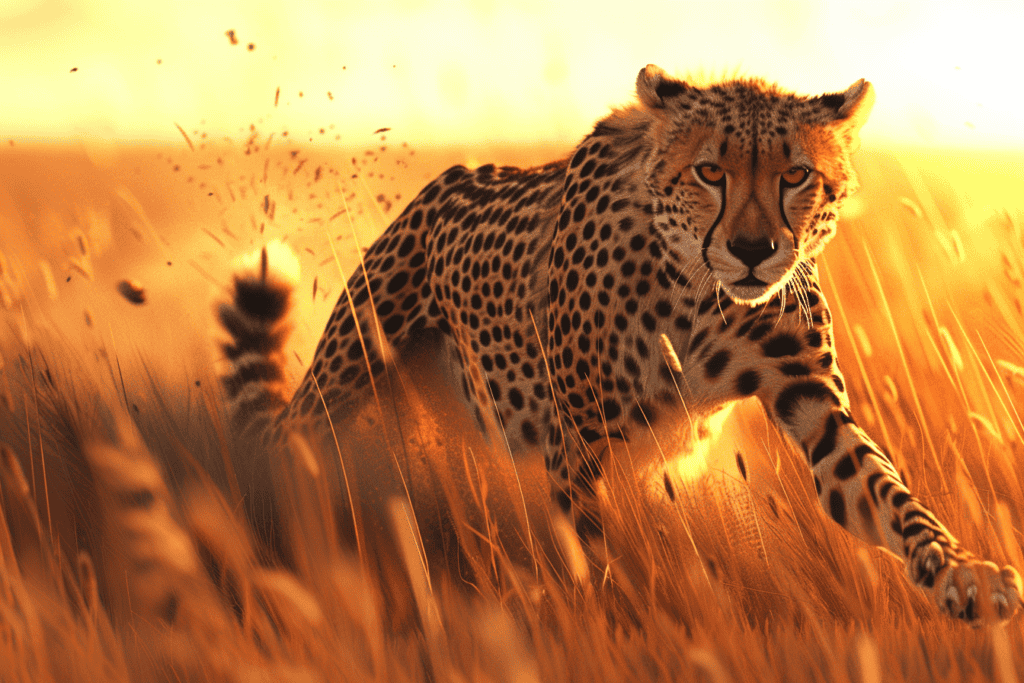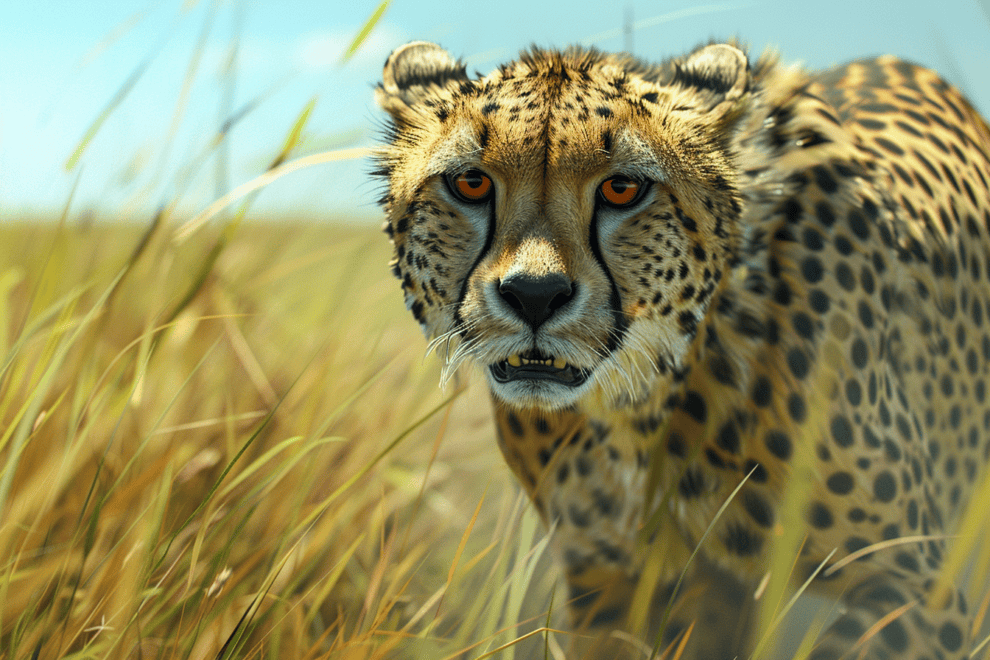Cheetahs are known for their extraordinary speed, making them one of the most fascinating creatures in the animal kingdom.
Their incredible hunting abilities are a result of their unique physical adaptations, which allow them to reach speeds of up to 75 miles per hour.
In this article, we will explore the fascinating world of cheetahs and their impressive hunting techniques.

As a hunter, the cheetah relies on its incredible speed to catch prey. The cheetah’s slender body, long legs, and flexible spine are all perfectly adapted for high-speed chases.
Their long tail serves as a rudder, helping them to maintain balance and change direction quickly. Additionally, their large nostrils and lungs allow them to take in more oxygen, providing the necessary energy for their explosive bursts of speed.
Despite their impressive speed, cheetahs are not built for endurance. They can only maintain their top speed for short distances, typically less than a minute.
As such, they must rely on their stealth and cunning to get close to their prey before launching their lightning-fast attack.
With their keen eyesight and ability to blend into their surroundings, cheetahs are skilled ambush predators, waiting patiently for the perfect moment to strike.
The Cheetah: Nature’s Speedy Predator
The cheetah (Acinonyx jubatus) is a majestic animal that is known for its incredible speed and agility. Its body is uniquely adapted to enable it to run at speeds of up to 75 miles per hour, making it the fastest land mammal on Earth.
The cheetah’s long, slender body, powerful muscles, and flexible spine help it to accelerate quickly and maintain high speeds over long distances.
The cheetah’s leg muscles are particularly impressive, as they allow the animal to take long strides and cover a lot of ground with each step.
In addition, the cheetah’s claws are semi-retractable, which helps it to grip the ground and maintain traction while running. These adaptations make the cheetah a formidable predator that is able to outrun most prey animals.
The Hunting Lifecycle
The cheetah’s hunting strategy is based on speed and agility. The animal stalks its prey, getting as close as possible before launching a lightning-fast attack.
The cheetah’s movements are carefully coordinated, with the animal using its tail to help it balance and steer while running.
Once the cheetah has caught its prey, it uses its powerful jaws to deliver a fatal bite to the neck or throat.
The animal’s strength and agility make it a highly efficient hunter, with a success rate of around 40-50%. However, the cheetah is also vulnerable to other predators, such as lions and hyenas, which will often steal its kills.
To survive in the wild, the cheetah has developed a number of unique adaptations. For example, the animal’s spotted coat helps it to blend in with its surroundings, making it less visible to prey animals.
The cheetah’s eyes are also specially adapted to help it spot movement from a long distance away, giving it an advantage when hunting.
Cheetahs in Their Natural Habitat

Surviving the Savannah
Cheetahs are remarkable animals that have adapted to survive in the African savannah. They are built for speed and agility, with long legs, a slender body, and sharp claws.
Their natural habitat is the grasslands, where they can easily camouflage themselves with their spotted fur.
In the wild, cheetahs are solitary animals that hunt during the day. They are known for their extraordinary hunting abilities, which rely heavily on their speed and agility.
Cheetahs can run at speeds of up to 70 miles per hour, making them the fastest land animals on earth. They use their speed to chase down prey, such as gazelles, impalas, and other small mammals.
Cheetahs are also excellent at camouflage, which helps them to avoid predators. Their spotted fur blends in with the grasslands, making it difficult for predators to spot them.
They are also able to hide in the tall grass, waiting for their prey to come closer before pouncing on them.
Cheetahs and Their Neighbors
Cheetahs share their natural habitat with many other animals, including lions, hyenas, and leopards. These animals are all predators that compete with cheetahs for food.
However, cheetahs are not as aggressive as their neighbors and will often give up their prey to avoid confrontation.
Despite the competition for food, cheetahs have adapted to coexist with their neighbors. They are able to hunt during the day when other predators are resting, and they are also able to outrun most of their competitors.
Additionally, cheetahs are able to survive on smaller prey, such as hares and birds, which are less desirable to other predators.
The Science Behind the Speed

Cheetahs are known for their incredible speed, but what makes them so fast?
It turns out that cheetahs have a number of unique adaptations that allow them to move at incredible speeds. One of these adaptations is their sensory superpowers.
Cheetahs have excellent eyesight, which allows them to spot prey from a distance.
Their eyes are specially adapted to help them see in low light conditions, which is important for hunting at dawn and dusk.
In addition to their eyesight, cheetahs also have an incredible sense of balance. Their vestibular system, which is located in their inner ear, helps them maintain their balance while running at high speeds.
This system is also responsible for helping cheetahs keep their head posture stable while running.
A Biological Blueprint for Velocity
Cheetahs have a number of unique physical adaptations that help them run at incredible speeds. For example, their long, slender bodies and powerful legs give them a long stride length, which allows them to cover more ground with each step.
Additionally, cheetahs have a flexible spine that allows them to make sharp turns while running.
Another important adaptation for speed is the cheetah’s respiratory system. Cheetahs have large lungs and a powerful heart, which allows them to take in and circulate oxygen efficiently.
This is important for running at high speeds, as it allows the cheetah to maintain its energy levels for longer periods of time.
Research has also shown that cheetahs have a unique muscle structure that allows them to run at high speeds for short bursts. Their muscles are designed for power and speed, rather than endurance.
Conserving the Fastest Land Animal

Unfortunately, the cheetah’s status as the fastest land animal does not guarantee its survival. Cheetahs are currently listed as a vulnerable species by the International Union for Conservation of Nature (IUCN), with only an estimated 7,100 individuals remaining in the wild.
The primary threats to cheetah populations include habitat loss, human-wildlife conflict, and poaching.
As human populations grow and expand into cheetah habitat, the cats are forced to compete with livestock for resources, leading to conflict with farmers and ranchers. Additionally, cheetahs are often hunted for their skin or captured for the illegal pet trade.
Despite these challenges, there is hope for the conservation of cheetahs. Conservation efforts are underway to protect cheetah habitat, reduce human-wildlife conflict, and combat poaching.
One such effort is the Cheetah Conservation Fund, which works to promote coexistence between humans and cheetahs through education and community-based conservation programs.
The organization also conducts research on cheetah behavior and ecology to better understand the cats’ needs and develop effective conservation strategies.
Another important aspect of cheetah conservation is raising awareness and promoting education.
By educating the public about the importance of cheetahs and their role in the ecosystem, we can inspire action and encourage support for conservation efforts.
It is also important to note that cheetah conservation is not just about preserving a single species, but about protecting entire ecosystems.
As apex predators, cheetahs play a crucial role in regulating prey populations and maintaining a healthy balance in their ecosystems.
Frequently Asked Questions

How do cheetahs achieve their incredible speed?
Cheetahs are the fastest land animals on earth. They are capable of reaching speeds of up to 70 miles per hour in just a few seconds.
What adaptations do cheetahs have for hunting?
Cheetahs are well-adapted for hunting, with several physical and behavioral adaptations that make them formidable predators. Their slender bodies and long legs allow them to run at incredible speeds, while their sharp claws and powerful jaws enable them to take down prey quickly and efficiently. Additionally, cheetahs have keen eyesight and hearing, which help them locate prey from a distance.
Why might speed not always be beneficial for cheetahs?
While speed is undoubtedly a crucial aspect of a cheetah’s hunting strategy, it is not always the most effective approach. For example, when hunting in dense vegetation or over long distances, speed may not be as advantageous as stealth and patience. Additionally, cheetahs must conserve their energy and avoid injury, as they are vulnerable to other predators such as lions and hyenas.
What strategies do cheetahs use to catch their prey?
Cheetahs use a variety of strategies to catch their prey, depending on the terrain and the type of prey they are hunting.
In open grasslands, cheetahs will often use their incredible speed to chase down prey, while in more wooded areas, they may rely on stealth and surprise to get close to their target.
Once within striking distance, cheetahs will use their sharp claws and powerful jaws to bring down their prey quickly.
How does the cheetah’s speed compare to other fast animals?
While cheetahs are the fastest land animals, there are other animals that are faster in other environments.
For example, peregrine falcons can reach speeds of up to 240 miles per hour when diving to catch prey, while sailfish can swim at speeds of up to 68 miles per hour. Nonetheless, cheetahs are still incredibly impressive animals, with a combination of speed, agility, and hunting prowess that is unmatched in the animal kingdom.
What role does agility play in a cheetah’s hunting technique?
In addition to their incredible speed, cheetahs are also incredibly agile. They have the ability to change direction quickly and make sharp turns at high speeds.
This agility is essential for catching prey, as it allows cheetahs to adjust their course mid-chase and make sudden movements to avoid obstacles.
Cheetahs are remarkable animals with a unique set of adaptations that allow them to excel as hunters in their natural environment.









